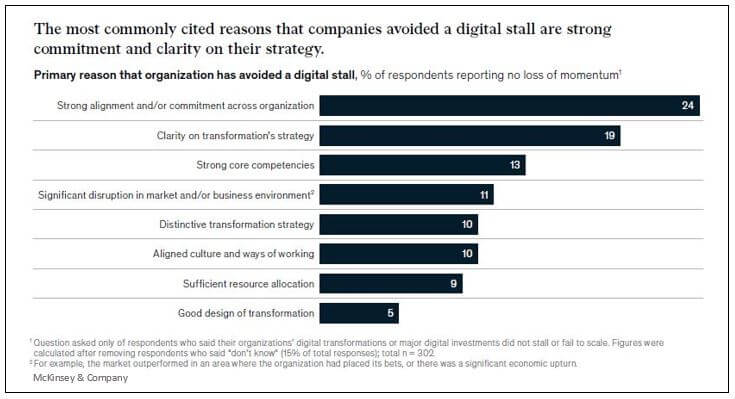While the term digital transformation seems to be everywhere, there are plenty of interpretations about what it means.
Here’s what IDC says: “Digital transformation is the disruptive change that organizations experience when they leverage digital innovation and creativity to fundamentally improve the business.”
Salesforce, on the other hand, says “digital transformation begins and ends with the customer.”
They are both right. These definitions are really two sides of the same coin. Digital transformation is about new ways of doing business and engaging customers.
Digital is essential
What digital transformation is not, is optional. The world is moving to a digital economy, quickly. That’s where the disruptive change that IDC includes in its definition comes in.
Companies can be the disrupters or the disrupted. Digital transformation leaders will embrace the change while keeping a sharp focus on the twin goals of improved operations and customer experience (CX).
5 Ways to Accelerate Digital Transformation
The future is increasingly digital, so companies need to adopt several strategies to advance decisively in the right direction.
- Move to digital platforms
Digital transformation starts with the shift to digital processes, but many companies are constrained by their existing IT infrastructure. Rather than upgrade legacy systems, more businesses are moving to cloud-based digital platforms, such as Expresso for managing customer communications. In doing so they divest manual and outdated processes and technology for those that are state of the art.
The advantages of leveraging platforms to digitally transform operations are clear: They are run by experts in those processes, providing instant access to the latest digital technology, ongoing innovation, flexibility, scalability and cost management.
- Invest in data analytics and management
While it makes sense to outsource or move some processes to the cloud, certain information and operations are core to each business. For Coca-Cola, it’s the formula for its most famous drink. For all businesses, it’s their customer and other proprietary data.
Parsing customer data is key to identifying unmet needs, uncovering new opportunities, removing friction and improving interactions to build loyalty and revenues. It’s reaching the point where businesses are only as good as their data, making data management and analytics fundamental strengths and marketplace differentiators. To avoid the “trash in, trash out” data phenomenon that threatens competitiveness, companies need to prioritize and protect their data assets.
- Leverage digital processes and data to boost CX
Once the digital foundation and data management is in place, companies can operationalize both to drive exceptional customer experience.
Take customer communications. Expresso gives companies control of the entire cycle from communications development to distribution to archiving and reporting, automating and streamlining each step to improve accuracy, speed and compliance.
Beyond operating efficiencies, Expresso enables companies to personalize everything from customer messaging to images to delivery channels. It also provides the platform to encourage and manage digital interactions, such as adding electronic statement options on mailed communications or even offering incentives for digital adoption.
- Stay the course.
This type of change is hard, and seven out of 10 organizations say their digital transformation efforts have slowed or stalled along the way, according to McKinsey. Six out of 10 times, it’s due to internal issues such as lack of clear digital strategy, resources or organizational focus, McKinsey says.
If your efforts sputter, McKinsey found that organizations that successfully restarted their initiatives relied on three interventions: undertaking a rigorous change-management program, improving the economic model for the transformation’s timing and impact, and developing a robust internal-communications plan.
Like most major change efforts, people make the difference. Digital transformation takes organizational buy-in and sustained leadership focus.

- It’s not all or nothing
While digital transformation drives efficiencies and CX, sometimes they come into conflict. That’s particularly apparent with customer communications. While companies like the savings from all-digital communications, few customers currently select that option and pushing too hard can be a customer turnoff. In fact, paper remains the preferred channel for most transactional communications.
While companies work on converting more customers to digital channels, they can still benefit from the digital processes powering Expresso to meet customers where they are at, from mail to mobile.
If you’d like to discuss how to capitalize on all of Expresso’s capabilities to accelerate digital transformation and digital adoption at your company, please contact us.